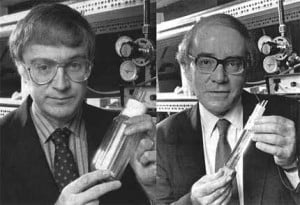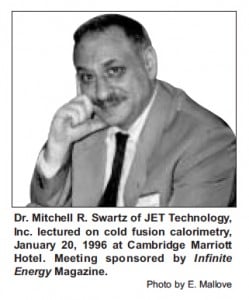First published by Infinite Energy IE24 in 1999, the MIT and Cold Fusion Special Report [.pdf] by Eugene Mallove featured a detailed history of the Massachusetts Institute of Technology’s (MIT) investigation into the claims made of cold fusion technology. The brief episode of research was undertaken by the MIT Plasma Fusion Center (PFC) in 1989 while Mallove was the school’s News Office Chief Science Writer. Mallove’s report on the hot-fusion scientist’s findings is fully documented with an analysis that shows a discrepancy between the original lab data and the data published in their final evaluation.

Upon learning of this breakthrough discovery, scientists around the world dropped what they were doing and attempted to reproduce the Fleischmann-Pons Effect (FPE). Brilliant individuals and talented researchers from a variety of disciplines, including hot fusion and plasma scientists, threw electro-chemical cells together using materials on hand, and attached a battery.
Unfortunately, for all the groups that attempted the experiment, there was only about a 15% success rate.
Most of the attempts to reproduce the effect failed, and many of the researchers saw nothing out of the ordinary happen.
Within months after the announcement, two of the top science institutes in the United States, with the power to shape policy at the highest levels, had declared cold fusion a ridiculous hoax.
More than any other factor, it was the negative reports by MIT on the east coast, and CalTech on the west, that influenced the U.S. federal policy of excluding cold fusion from the energy portfolio.
Federal agencies cited the recommendations from MIT and CalTech as a basis for their policy.
 PFC Director Ronald Parker and professor Dr. Richard Petrasso wrote the MIT final report, making the claim that the Utah scientists had “misinterpreted” their results.
PFC Director Ronald Parker and professor Dr. Richard Petrasso wrote the MIT final report, making the claim that the Utah scientists had “misinterpreted” their results.
Quoting Mallove’s account, scientists at MIT claimed that “tritium detection in cold fusion experiments at Los Alamos National Laboratory should be ignored because it had been done by ‘third-rate scientists'”. They were of course talking about Dr. Edmund Storms and Dr. Carol Talcott, specialists on tritium and metal-hydrides who were measuring “significant amounts of tritium” along with others teams at the national lab.
MIT and CalTech expert opinions were broadcast through the TV/satellite peak of power, just as the Internet was first emerging in the civilian sphere. The message was total. In a story to the press, Parker characterized the work of Fleischmann and Pons as “scientific schlock” and “possible fraud”.
Though he first denied saying anything of the kind, an audio tape made by the reporter confirmed his particular language. The same vocabulary was unleashed on May 1, 1989 at the Baltimore meeting of the American Physical Society with an emotional vehemence uncharacteristic of scientific objectivity.
While Director Parker was meeting with Boston Herald reporter Nick Tate, he took a phone call from NBC-TV news Science Reporter Robert Bazell during the interview. The press eventually ran the message that cold fusion was a big mistake. Since then, virtually no coverage of cold fusion breakthroughs have been broadcast, with the exception the 2009 CBS 60mins report Cold Fusion More Than Junk Science.
During the Herald interview, Parker also took a phone call from Richard Garwin, Chief Science Researcher at IBM Corporation and a member of the Energy Research Advisory Board tasked by then-Secretary of Energy James Watkins with determining the federal response to cold fusion. The ERAB ultimately decided there was no need to investigate the phenomenon further.
In the years that followed, then-President of MIT Charles M. Vest was also on a federal panel that advised President Bill Clinton’s administration to increase funding for hot fusion. The U.S. Department of Energy (DoE) has refused to even acknowledge the existence of cold fusion, resulting in no research funding for over twenty-years, including their $29 billion 2012 budget.
These reports were cited by the U.S. Patent and Trademark Office (USPTO) to justify diverting cold fusion patents out of the normal processing stream. Mallove stated that the MIT report effectively “killed the Pons and Fleischmann patent, which happened in the Fall of 1997”.
The meme created by MIT and CalTech in 1989 remains in scientific and political circles to this day: that cold fusion is a phenomenon imagined in the minds of lesser scientists.

 Dr. Vesco Noninski was first to be curious about the MIT cold fusion experimental data. A subsequent analysis performed by MIT alumnus Dr. Mitchell Swartz, now of JET Energy, confirmed discrepancies between the original lab data and the reported data. The MIT reported data appears to be shifted downward, indicating that excess heat may have been measured, as represented by the higher-temperature lab data.
Dr. Vesco Noninski was first to be curious about the MIT cold fusion experimental data. A subsequent analysis performed by MIT alumnus Dr. Mitchell Swartz, now of JET Energy, confirmed discrepancies between the original lab data and the reported data. The MIT reported data appears to be shifted downward, indicating that excess heat may have been measured, as represented by the higher-temperature lab data.
Swartz detailed his findings in three papers which can be found in the Proceedings of ICCF-4 prepared by the Electric Power Research Institute in 1993: “Re-Examination of a Key Cold Fusion Experiment: ‘Phase-II’ Calorimetry by the MIT Plasma Fusion Center“, “A Method to Improve Algorithms Used to Detect Steady State Excess Enthalpy” and “Some Lessons from Optical Examination of the PFC Phase-II Calorimetric Curves“. [download .pdf]
But the damage had been done. Administrators were not interested in re-visiting an already dismissed claim.
If it were not for that lucky 15%, we would not have known anything different, and prospects for a clean energy future would indeed be gloomy.
It is now known that for the types of palladium-deuterium electrolytic cells that they were experimenting with, significantly long times are needed to “load” the deuterium into the palladium. Weeks, or even months, could go by before excess heat would be produced. Turning on the cell in the morning, and expecting the effect to occur by dinner, was unreasonable.
In addition, scientists who were experts in their own field were not necessarily skilled in the complex art of electro-chemical cells. Measuring heat, a science in itself called calorimetry, is difficult for an experienced electro-chemist, let alone a novice. Experiments done by both MIT and CalTech were plagued with poor calorimetry.
Swartz’ examinations of MIT data twenty-years ago were recently appended when Melvin Miles and Peter Hagelstein re-visited the PFC’s experimental procedures of calorimetry. Miles and Hagelstein published their analysis in the Journal of Condensed Matter Nuclear Science Volume 8 2012 pages 132-138 [download .pdf]
Miles is a retired Professor and Navy researcher who is an expert in measuring heat. Hagelstein is MIT Professor of Electrical Engineering who has theorized on the nature of the cold fusion reaction. Hagelstein has collaborated with Mitchell Swartz over the years on several IAP short courses and public demonstrations of active cells on the MIT campus without the official support of MIT. The most recent cold fusion cell continues to produce excess heat for six months now.
The summary of the Miles and Hagelstein calorimetry analysis is reproduced here:
The 1989 report from MIT remains flawed with unjustified shifts of temperature plots and poor calorimetry procedures. Yet this report, along with the CalTech conclusions, established the baseline for all academic and federal policy over two decades.
Twenty-years ago, Dr. Charles McCutchen of the National Institute of Health (NIH) responding to Eugene Mallove’s request to examine the MIT PFC data, asked MIT President Vest:
“For its own good, and to restore some civility to a contentious field, MIT should look into (1) how its scientists came to perform and publish such a poor experiment, (2) why they either misdescribed their results, making them seem more meaningful than they were or used a subtle correcting procedure without describing exactly what it was, (3) how it came about that data from calorimeters with a claimed sensitivity of 40 mw converged, between drafts, after completion of the experiments, to within perhaps 5 mw of the result that hot fusion people would prefer to see. It might have been chance, but it might not.” –Charles McCutchen NIH 1992
In light of the problems that characterized the Plasma Fusion Center’s experiments over those few months in 1989, and in light of the twenty-three years of research confirming without a doubt the existence of a form of energy that is dense, safe and ultra-clean, both MIT and CalTech have two choices: implement Dr. McCutchen’s recommendations, or, remove any long-standing institutional blocks that have kept research on cold fusion out of the most prestigious science schools in the U.S., and begin again by instituting a serious program to understand and develop what is now called condensed matter nuclear science (CMNS).
Both MIT and CalTech have refused donor money for cold fusion research. Most recently, an “MIT physicist” denied a group’s ability to fund Hagelstein’s research by actually returning the dollars. Meanwhile, the University of Missouri increases its support for new-energy company Energetics Technologies with private donations over $5 million. For elite science schools like MIT and CalTech to ignore the reality of cold fusion is not only a threat to the integrity of our institutions of science, but a threat to our planet.
There is alot of catching up to do in order to develop the myriad of technologies that will allow humankind a second chance at living a technological future, in peace, on a green planet Earth, and we need our most talented and creative minds to do it.
New-Energy Program begins tomorrow!
Opening party starts at 4PM.
Related Links
How Nature refused to re-examine the 1989 CalTech experiment by Jed Rothwell [.pdf]
JET Energy NANOR device at MIT continues to operate months later by Ruby Carat May 22, 2012
1994 BBC doc profiles early history of cold fusion underground by Ruby Carat June 7, 2012
International Society of Condensed Matter Nuclear Science Publications


